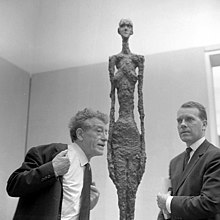Oil Painting » List of Painters » Alberto Giacometti
Alberto Giacometti (October 10, 1901 – January 11, 1966) was a surrealist sculptor and painter.
EARLY DAYS:
Alberto Giacometti was a Swiss sculptor, painter, and draughtsman who contributed greatly to the Surrealist art movement. He was born in Borgonovo, Switzerland in 1901 and grew up in a small mountain village. His father was a postman and amateur painter and his mother was a seamstress. Giacometti was educated in Geneva and moved to Paris in 1922 to pursue an artistic career.
Giacometti's early works were deeply influenced by Surrealism, as he was a close friend of Andr? Breton, the leader of the movement. His first exhibition came in 1927 at the Galerie Pierre in Paris. At this time, he was creating works with an abstract, almost cubist style. His sculptures were often made of plaster, stone, and bronze and were characterized by their thin, elongated forms. He was particularly interested in representing the human figure and was influenced by African and Oceanic art.
In 1929, Giacometti met the surrealist artist, Max Ernst, and the two had a huge impact on each other's work. Giacometti's sculptures became increasingly figurative, and Ernst's art became more abstract. The two also collaborated on a short film, Le Myst?re Picasso.
Giacometti continued to experiment with his art during the 1930s. He developed an interest in the Existentialist philosopher, Jean-Paul Sartre, and began to focus on the human condition. He began to create sculptures of isolated figures and figures in pairs, exploring loneliness and alienation. He also created a series of busts, inspired by his own reflection in a broken mirror. Giacometti's art became increasingly abstract and minimalistic, focusing on the essence of the human figure.
In the 1940s, Giacometti returned to figurative sculpture and began to create works that were more realistic. His sculptures were now characterized by their thin and elongated figures, and the figures were often depicted in a state of tension. He was particularly interested in capturing the human struggle and the sense of alienation and despair that many people felt during this period.
Giacometti's later works continued to explore the human experience and the themes of alienation and despair. He also began to create sculptures of animals, such as birds and cats, which he saw as symbols of freedom and hope.
Giacometti's work has had a lasting impact on the art world and continues to inspire contemporary artists. His sculptures, paintings, and drawings have been widely exhibited, and his work can be found in major museums around the world. Giacometti died in 1966, but his legacy lives on.

Personal Details
| Name | Alberto Giacometti |
| Place of birth | Switzerland |
| Date of Birth | 10 October 1901 |
| Date of Death | 11 January 1966 |
| Nationality | Swiss |
| Field | Sculpture, painting, drawing |
CAREER:
Giacometti began studying art in Geneva in 1919. He was initially influenced by cubism and surrealism, and later developed a more abstract approach to his work. He moved to Paris in 1922 to study at the ?cole des Beaux-Arts and the Acad?mie de la Grande Chaumi?re. During this time, he was heavily influenced by the works of Auguste Rodin and Constantin Brancusi. He also became a part of the Surrealist movement and was friends with artists such as Andr? Breton and Salvador Dali.
In 1925, Giacometti had his first solo exhibition in Paris. This exhibition featured some of his earliest sculptures, which were highly abstract in nature. This exhibition marked the beginning of his career as a sculptor. He started to experiment with various materials, such as bronze and clay, and created sculptures of figures in a variety of poses.
In the 1930s, Giacometti began to develop a new style of sculpture, which focused on capturing the essence of the human form. He started to create sculptures of elongated figures, which he believed expressed the true nature of the human experience. This style of work would become his signature style and would be heavily influential in the development of modern sculpture.
During World War II, Giacometti moved back to Switzerland and stopped producing sculptures. He instead focused on painting and drawing, which allowed him to explore different themes and techniques. After the war, he returned to Paris and began to produce sculptures again. He also started to experiment with larger sculptures and began to incorporate his painting and drawing techniques into his work.
Giacometti's sculptures achieved great success and he had several solo exhibitions throughout Europe and the United States. In 1961, he was awarded the Grand Prize for Sculpture at the Venice Biennale. He also received numerous awards throughout his career, including the Grand Cross of Merit of the Federal Republic of Germany



